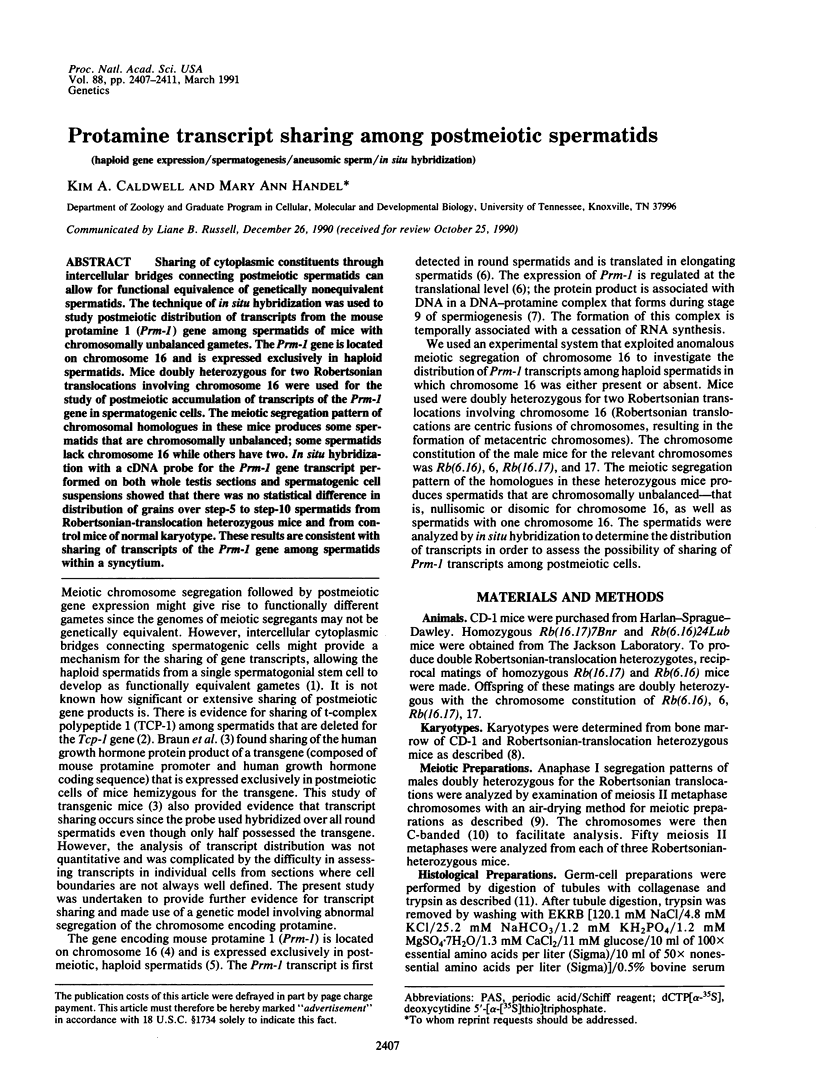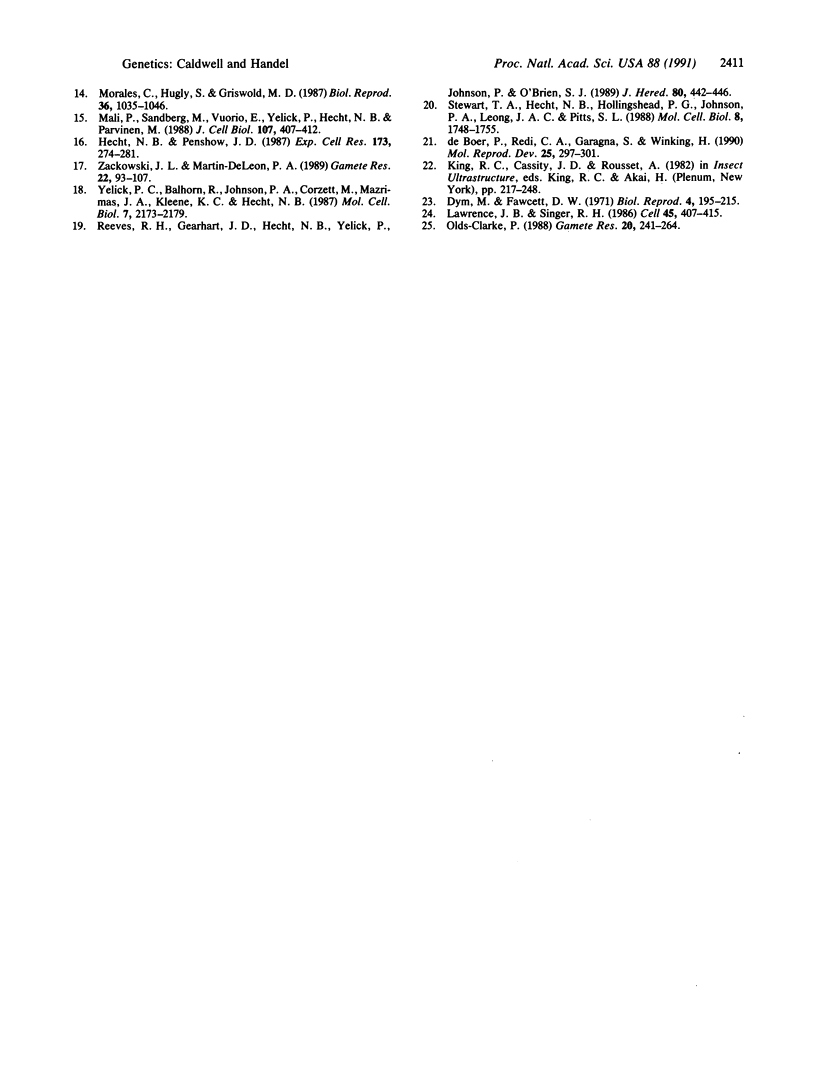Abstract
Sharing of cytoplasmic constituents through intercellular bridges connecting postmeiotic spermatids can allow for functional equivalence of genetically nonequivalent spermatids. The technique of in situ hybridization was used to study postmeiotic distribution of transcripts from the mouse protamine 1 (Prm-1) gene among spermatids of mice with chromosomally unbalanced gametes. The Prm-1 gene is located on chromosome 16 and is expressed exclusively in haploid spermatids. Mice doubly heterozygous for two Robertsonian translocations involving chromosome 16 were used for the study of postmeiotic accumulation of transcripts of the Prm-1 gene in spermatogenic cells. The meiotic segregation pattern of chromosomal homologues in these mice produces some spermatids that are chromosomally unbalanced; some spermatids lack chromosome 16 while others have two. In situ hybridization with a cDNA probe for the Prm-1 gene transcript performed on both whole testis sections and spermatogenic cell suspensions showed that there was no statistical difference in distribution of grains over step-5 to step-10 spermatids from Robertsonian-translocation heterozygous mice and from control mice of normal karyotype. These results are consistent with sharing of transcripts of the Prm-1 gene among spermatids within a syncytium.
Full text
PDF




Images in this article
Selected References
These references are in PubMed. This may not be the complete list of references from this article.
- Alonso S., Minty A., Bourlet Y., Buckingham M. Comparison of three actin-coding sequences in the mouse; evolutionary relationships between the actin genes of warm-blooded vertebrates. J Mol Evol. 1986;23(1):11–22. doi: 10.1007/BF02100994. [DOI] [PubMed] [Google Scholar]
- Braun R. E., Behringer R. R., Peschon J. J., Brinster R. L., Palmiter R. D. Genetically haploid spermatids are phenotypically diploid. Nature. 1989 Jan 26;337(6205):373–376. doi: 10.1038/337373a0. [DOI] [PubMed] [Google Scholar]
- Chandley A. C., Fletcher J. M. Centromere staining at meiosis in man. Humangenetik. 1973 May 25;18(3):247–252. doi: 10.1007/BF00290604. [DOI] [PubMed] [Google Scholar]
- Dym M., Fawcett D. W. Further observations on the numbers of spermatogonia, spermatocytes, and spermatids connected by intercellular bridges in the mammalian testis. Biol Reprod. 1971 Apr;4(2):195–215. doi: 10.1093/biolreprod/4.2.195. [DOI] [PubMed] [Google Scholar]
- EVANS E. P., BRECKON G., FORD C. E. AN AIR-DRYING METHOD FOR MEIOTIC PREPARATIONS FROM MAMMALIAN TESTES. Cytogenetics. 1964;3:289–294. doi: 10.1159/000129818. [DOI] [PubMed] [Google Scholar]
- Eicher E. M., Washburn L. L. Assignment of genes to regions of mouse chromosomes. Proc Natl Acad Sci U S A. 1978 Feb;75(2):946–950. doi: 10.1073/pnas.75.2.946. [DOI] [PMC free article] [PubMed] [Google Scholar]
- Feinberg A. P., Vogelstein B. A technique for radiolabeling DNA restriction endonuclease fragments to high specific activity. Anal Biochem. 1983 Jul 1;132(1):6–13. doi: 10.1016/0003-2697(83)90418-9. [DOI] [PubMed] [Google Scholar]
- Handel M. A. Genetic control of spermatogenesis in mice. Results Probl Cell Differ. 1987;15:1–62. doi: 10.1007/978-3-540-47184-4_1. [DOI] [PubMed] [Google Scholar]
- Hecht N. B., Kleene K. C., Yelick P. C., Johnson P. A., Pravtcheva D. D., Ruddle F. H. Mapping of haploid expressed genes: genes for both mouse protamines are located on chromosome 16. Somat Cell Mol Genet. 1986 Mar;12(2):203–208. doi: 10.1007/BF01560667. [DOI] [PubMed] [Google Scholar]
- Hecht N. B., Penshow J. D. In situ localization of mRNAs coding for mouse testicular structural genes. Exp Cell Res. 1987 Nov;173(1):274–281. doi: 10.1016/0014-4827(87)90353-3. [DOI] [PubMed] [Google Scholar]
- Kleene K. C., Distel R. J., Hecht N. B. Nucleotide sequence of a cDNA clone encoding mouse protamine 1. Biochemistry. 1985 Jan 29;24(3):719–722. doi: 10.1021/bi00324a027. [DOI] [PubMed] [Google Scholar]
- Kleene K. C., Distel R. J., Hecht N. B. Translational regulation and deadenylation of a protamine mRNA during spermiogenesis in the mouse. Dev Biol. 1984 Sep;105(1):71–79. doi: 10.1016/0012-1606(84)90262-8. [DOI] [PubMed] [Google Scholar]
- Kleene K. C., Distel R. J., Hecht N. B. cDNA clones encoding cytoplasmic poly(A)+ RNAs which first appear at detectable levels in haploid phases of spermatogenesis in the mouse. Dev Biol. 1983 Aug;98(2):455–464. doi: 10.1016/0012-1606(83)90375-5. [DOI] [PubMed] [Google Scholar]
- Lawrence J. B., Singer R. H. Intracellular localization of messenger RNAs for cytoskeletal proteins. Cell. 1986 May 9;45(3):407–415. doi: 10.1016/0092-8674(86)90326-0. [DOI] [PubMed] [Google Scholar]
- Mali P., Sandberg M., Vuorio E., Yelick P. C., Hecht N. B., Parvinen M. Localization of protamine 1 mRNA in different stages of the cycle of the rat seminiferous epithelium. J Cell Biol. 1988 Aug;107(2):407–412. doi: 10.1083/jcb.107.2.407. [DOI] [PMC free article] [PubMed] [Google Scholar]
- Morales C., Hugly S., Griswold M. D. Stage-dependent levels of specific mRNA transcripts in Sertoli cells. Biol Reprod. 1987 May;36(4):1035–1046. doi: 10.1095/biolreprod36.4.1035. [DOI] [PubMed] [Google Scholar]
- Olds-Clarke P. Genetic analysis of sperm function in fertilization. Gamete Res. 1988 Jun;20(2):241–264. doi: 10.1002/mrd.1120200214. [DOI] [PubMed] [Google Scholar]
- Reeves R. H., Gearhart J. D., Hecht N. B., Yelick P., Johnson P., O'Brien S. J. Mapping of PRM1 to human chromosome 16 and tight linkage of Prm-1 and Prm-2 on mouse chromosome 16. J Hered. 1989 Nov-Dec;80(6):442–446. doi: 10.1093/oxfordjournals.jhered.a110895. [DOI] [PubMed] [Google Scholar]
- Romrell L. J., Bellvé A. R., Fawcett D. W. Separation of mouse spermatogenic cells by sedimentation velocity. A morphological characterization. Dev Biol. 1976 Mar;49(1):119–131. doi: 10.1016/0012-1606(76)90262-1. [DOI] [PubMed] [Google Scholar]
- Stewart T. A., Hecht N. B., Hollingshead P. G., Johnson P. A., Leong J. A., Pitts S. L. Haploid-specific transcription of protamine-myc and protamine-T-antigen fusion genes in transgenic mice. Mol Cell Biol. 1988 Apr;8(4):1748–1755. doi: 10.1128/mcb.8.4.1748. [DOI] [PMC free article] [PubMed] [Google Scholar]
- Yelick P. C., Balhorn R., Johnson P. A., Corzett M., Mazrimas J. A., Kleene K. C., Hecht N. B. Mouse protamine 2 is synthesized as a precursor whereas mouse protamine 1 is not. Mol Cell Biol. 1987 Jun;7(6):2173–2179. doi: 10.1128/mcb.7.6.2173. [DOI] [PMC free article] [PubMed] [Google Scholar]
- Zackowski J. L., Martin-DeLeon P. A. Segregation products of male mice doubly heterozygous for the RB(6.16) and RB (16.17) translocations: influence of sperm karyotype on fertilizing competence under varying mating frequencies. Gamete Res. 1989 Jan;22(1):93–107. doi: 10.1002/mrd.1120220110. [DOI] [PubMed] [Google Scholar]
- de Boer P., Redi C. A., Garagna S., Winking H. Protamine amount and cross linking in mouse teratospermatozoa and aneuploid spermatozoa. Mol Reprod Dev. 1990 Mar;25(3):297–301. doi: 10.1002/mrd.1080250312. [DOI] [PubMed] [Google Scholar]



